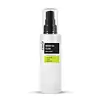What's inside
What's inside
 Key Ingredients
Key Ingredients

 Benefits
Benefits

 Concerns
Concerns

No concerns
 Ingredients Side-by-side
Ingredients Side-by-side

Water
Skin ConditioningButylene Glycol
HumectantCaprylic/Capric Triglyceride
MaskingHelianthus Annuus Seed Oil
EmollientParaffinum Liquidum
EmollientCetyl Ethylhexanoate
EmollientSodium Hyaluronate
HumectantArachidyl Alcohol
EmollientBehenyl Alcohol
EmollientArachidyl Glucoside
EmulsifyingCyclomethicone
EmollientAloe Barbadensis Leaf Extract
EmollientGlyceryl Stearate
EmollientPEG-100 Stearate
Sorbitan Stearate
EmulsifyingPolysorbate 60
EmulsifyingDiisostearyl Malate
EmollientDimethicone
EmollientHydrogenated Lecithin
EmulsifyingAllantoin
Skin ConditioningTriethanolamine
BufferingXanthan Gum
EmulsifyingTocopheryl Acetate
AntioxidantCamellia Sinensis Leaf Extract
AntimicrobialPanax Ginseng Root Extract
EmollientHoney
HumectantRosa Multiflora Fruit Extract
MaskingGardenia Florida Fruit Extract
Skin ConditioningScutellaria Baicalensis Root Extract
AstringentLigustrum Japonicum Fruit Extract
Skin ConditioningAcanthopanax Senticosus Root Extract
Skin ConditioningPunica Granatum Fruit Extract
AntioxidantCarthamus Tinctorius Flower Extract
Skin ConditioningCarbomer
Emulsion StabilisingDisodium EDTA
Leontopodium Alpinum Extract
Skin ConditioningThymus Vulgaris Extract
PerfumingMalva Sylvestris Flower Extract
Skin ConditioningBambusa Vulgaris Leaf/Stem Extract
HumectantSnail Secretion Filtrate
Skin ConditioningPhenoxyethanol
PreservativeEthylhexylglycerin
Skin ConditioningParfum
MaskingWater, Butylene Glycol, Caprylic/Capric Triglyceride, Helianthus Annuus Seed Oil, Paraffinum Liquidum, Cetyl Ethylhexanoate, Sodium Hyaluronate, Arachidyl Alcohol, Behenyl Alcohol, Arachidyl Glucoside, Cyclomethicone, Aloe Barbadensis Leaf Extract, Glyceryl Stearate, PEG-100 Stearate, Sorbitan Stearate, Polysorbate 60, Diisostearyl Malate, Dimethicone, Hydrogenated Lecithin, Allantoin, Triethanolamine, Xanthan Gum, Tocopheryl Acetate, Camellia Sinensis Leaf Extract, Panax Ginseng Root Extract, Honey, Rosa Multiflora Fruit Extract, Gardenia Florida Fruit Extract, Scutellaria Baicalensis Root Extract, Ligustrum Japonicum Fruit Extract, Acanthopanax Senticosus Root Extract, Punica Granatum Fruit Extract, Carthamus Tinctorius Flower Extract, Carbomer, Disodium EDTA, Leontopodium Alpinum Extract, Thymus Vulgaris Extract, Malva Sylvestris Flower Extract, Bambusa Vulgaris Leaf/Stem Extract, Snail Secretion Filtrate, Phenoxyethanol, Ethylhexylglycerin, Parfum
 Reviews
Reviews

Ingredients Explained
These ingredients are found in both products.
Ingredients higher up in an ingredient list are typically present in a larger amount.
Allantoin is a soothing ingredient known for its protective and moisturizingg properties. Because of this, it is often added to products with strong active ingredients.
Studies show higher concentrations of this ingredient can promote wound healing.
Though it can be derived from the comfrey plant, allantoin is produced synthetically for cosmetic products to ensure purity.
Learn more about AllantoinButylene Glycol (or BG) is used within cosmetic products for a few different reasons:
Overall, Butylene Glycol is a safe and well-rounded ingredient that works well with other ingredients.
Though this ingredient works well with most skin types, some people with sensitive skin may experience a reaction such as allergic rashes, closed comedones, or itchiness.
Learn more about Butylene GlycolCarbomer is a polymer of acrylic acid. Its main role is to create a gel consistency.
A high amount of carbomer can cause pilling or balling up of products. Don't worry, most products contain 1% or less of carbomer.
Phenoxyethanol is a preservative that has germicide, antimicrobial, and aromatic properties. Studies show that phenoxyethanol can prevent microbial growth. By itself, it has a scent that is similar to that of a rose.
It's often used in formulations along with Caprylyl Glycol to preserve the shelf life of products.
Snail Secretion Filtrate is the excretion from snails. It is an effective moisturizer and promotes collagen production.
A popular nickname for this ingredient is 'Snail Mucin'.
Snail mucin has numerous skin benefits:
On top of this, Snail Secretion Filtrate contains a variety of vitamins and minerals. These include copper peptides, Vitamin A, and vitamin E. Vitamins A and E are antioxidants. Antioxidants help fight free-radicals that damage skin cells.
Being cruelty-free means a brand does not experiment on animals.
If you're worried about the well-being of the snails, we recommend looking more into the company of the product. Many brands have developed humane methods to collect snail mucin.
There is much debate on this subject. On one hand, this ingredient comes from an animal. On the other hand, many will argue the ingredient is naturally secreted (like a natural by-product) and therefore vegan. If you have reservations, you can look into Galactomyces Ferment Filtrate or Centella Asiatica Extract as alternatives.
Learn more about Snail Secretion FiltrateSodium Hyaluronate is hyaluronic acid's salt form. It is commonly derived from the sodium salt of hyaluronic acid.
Like hyaluronic acid, it is great at holding water and acts as a humectant. This makes it a great skin hydrating ingredient.
Sodium Hyaluronate is naturally occurring in our bodies and is mostly found in eye fluid and joints.
These are some other common types of Hyaluronic Acid:
Learn more about Sodium Hyaluronate